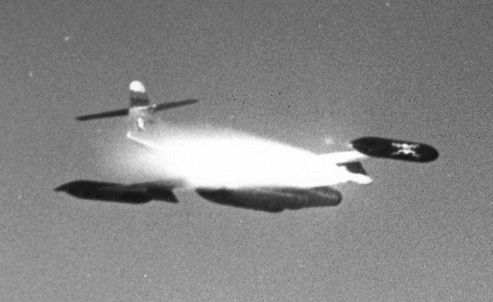
During 1957, a series of 29 nuclear weapons tests were carried out at the United States’ Nevada Test Site, 65 miles (105 kilometers) northwest of Las Vegas, Nevada, under Project Plumbbob. Shot John was the first and only firing of a live, nuclear-armed, air-to-air anti-aircraft missile.
On Friday morning, 19 July 1957, a United States Air Force Northrop F-89J Scorpion interceptor, serial number 53-2547, flown by Captain Eric W. Hutchison, Pilot, and Captain Alfred C. Barbee, Radar Intercept Officer, launched a Genie MB-1 unguided rocket at an altitude of 18,500 feet (5,640 meters) over NTS Area 10.

The rocket accelerated to Mach 3 and traveled 2.6 miles (4,250 meters) in 4.5 seconds when, at 07:00:04.6 a.m., Pacific Daylight Savings Time (14:00 UTC), its W-25 warhead was detonated by a signal from a ground station. The resulting explosive yield was 1.7 kilotons.

Interestingly, five U.S. Air Force officers and a photographer were standing directly under the air burst. This was an attempt by the Air Force to assuage public fears about the use of nuclear-armed anti-aircraft missiles over populated areas.

 The Northrop Corporation F-89J Scorpion was a two-place, twin-engine, sub-sonic all-weather interceptor. It was flown by a pilot and radar intercept officer in a tandem cockpit. It had a straight wing at mid-fuselage and a “T” tail horizontal stabilizer. Earlier variants of the Scorpion were armed with machine guns and rockets, but the F-89J carried only rockets and guided missiles.
The Northrop Corporation F-89J Scorpion was a two-place, twin-engine, sub-sonic all-weather interceptor. It was flown by a pilot and radar intercept officer in a tandem cockpit. It had a straight wing at mid-fuselage and a “T” tail horizontal stabilizer. Earlier variants of the Scorpion were armed with machine guns and rockets, but the F-89J carried only rockets and guided missiles.

F-89J 53-2547 was built as an F-89D-60-NO Scorpion, and was one of 350 D-models which were upgraded to the F-89J standard. It was a missile-armed all-weather interceptor with a two man crew assigned to the Air Defense Command.
The Northrop F-89J Scorpion was 53 feet, 8.4 inches long (16.368 meters) with a wingspan of 59 feet, 9.6 inches (18.227 meters) and overall height of 17 feet, 6 inches (5.334 meters). The leading edge of the interceptor’s wings were swept aft 5° 8′. The angle of incidence was 1° 30′, with no twist, and 1° 0′ dihedral. The total wing area was 606 square feet (56.30 square meters).
The F-89J had an empty weight of 26,883 pounds (12,194 kilograms) and maximum takeoff weight of 47,719 pounds (21,645 kilograms).
The F-89J Scorpion was powered by two General Electric-designed, Allison Engine Company-built, J35-A-35 engines. The J35 was a single-spool, axial-flow turbojet engine with an 11-stage compressor section and single-stage turbine. The J35-A-33 had a Normal (continuous) power rating of 4,855 pounds of thrust (21.596 kilonewtons) at 7,400 r.p.m. The Military Power rating was 5,440 pounds (24.198 kilonewtons) at 8,000 r.p.m. (30 minute limit), and it could produce a maximum 7,200 pounds of thrust (32.027 kilonewtons) at 8,000 r.p.m., with afterburner (5 minute limit). The engine was 16 feet, 3.5 inches (4.966 meters) long, 3 feet, 1.0 inches (0.940 meters) in diameter and weighed 2,830 pounds (1,284 kilograms).

The F-89J had a cruise speed of 402 knots (463 miles per hour/745 kilometers per hour) and a maximum speed of 528 knots (608 miles per hour/978 kilometers per hour) at 11,100 feet (3,383 meters). The service ceiling was 43,900 feet (13,381 meters). The interceptor’s combat radius was 435 nautical miles (501 statute miles/806 kilometers), and the maximum ferry range was 1,498 nautical miles (1,724 statute miles/2774 kilometers).
The F-89J could be armed with two MB-1 Genie rockets and four Hughes GAR-2A (AIM-4C) Falcon infrared-seeking air-to-air missiles; or two MB-1 Genies and 104 2.75-inch Folding-Fin Aerial Rockets (FFAR).
F-89s served with the U.S. Air Force and Air National Guard from 1948 until 1969. Northrop F-89J Scorpion 53-2547 was transferred to the Montana Air National Guard in 1960. It is on display at the Air National Guard Base, Great Falls, Montana.

The Douglas Aircraft Company, Missiles and Space Systems Division MB-1 Genie (AIR-2 after June 1963) was an unguided, nuclear-armed, air-to-air anti-aircraft rocket. Its solid-fuel Thiokol SR49-TC-1 engine produced 36,500 pounds of thrust (162.360 kilonewtons) and gave the Genie a maximum speed of Mach 3.3. Its range was 6 miles (9.6 kilometers). The rocket weighed 822 pounds (373 kilograms) with its W-25 warhead, and was 9 feet, 8 inches (2.946 meters) in length, with a maximum diameter of 1 foot, 5.5 inches (0.445 meters). The fins spanned 3 feet, 4 inches (1.118 meters). In production from 1957 to 1962, 3,150 missiles were produced. The Genie was in service from 1957 to 1988.

 The W-25 was a Los Alamos Scientific Laboratory-designed anti-aircraft warhead. It was a fission device, using implosion of both uranium and plutonium. The warhead’s diameter was 17.35 inches, and it was 26.6 inches long. The warhead weighed 221 pounds (100 kilograms). The W-25 was produced from May 1957 to May 1960. All had been retired by December 1984.
The W-25 was a Los Alamos Scientific Laboratory-designed anti-aircraft warhead. It was a fission device, using implosion of both uranium and plutonium. The warhead’s diameter was 17.35 inches, and it was 26.6 inches long. The warhead weighed 221 pounds (100 kilograms). The W-25 was produced from May 1957 to May 1960. All had been retired by December 1984.
Detonation was by time delay fuse. Lethal radius of the warhead was estimated to be approximately 1,000 feet (300 meters).

© 2018, Bryan R. Swopes